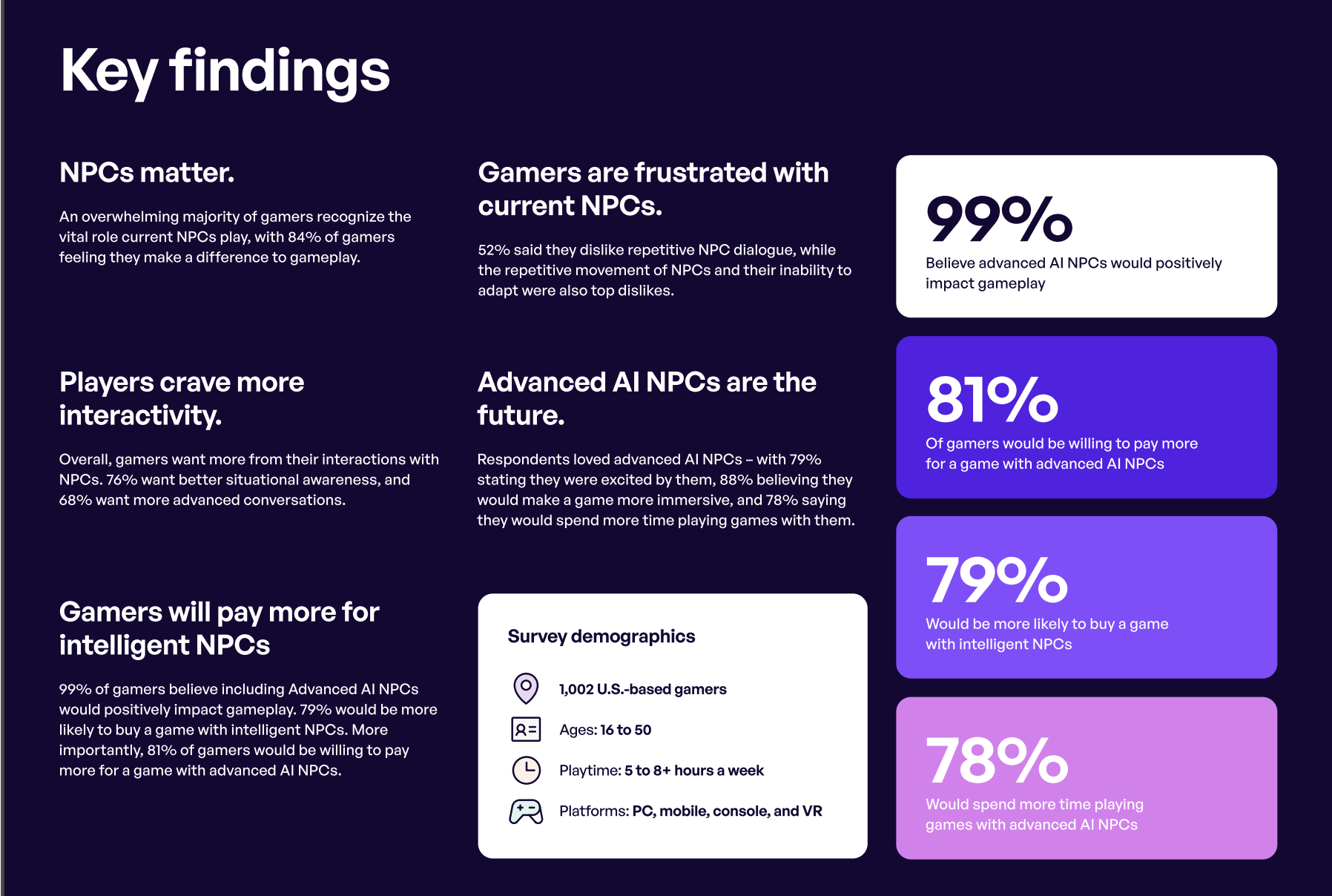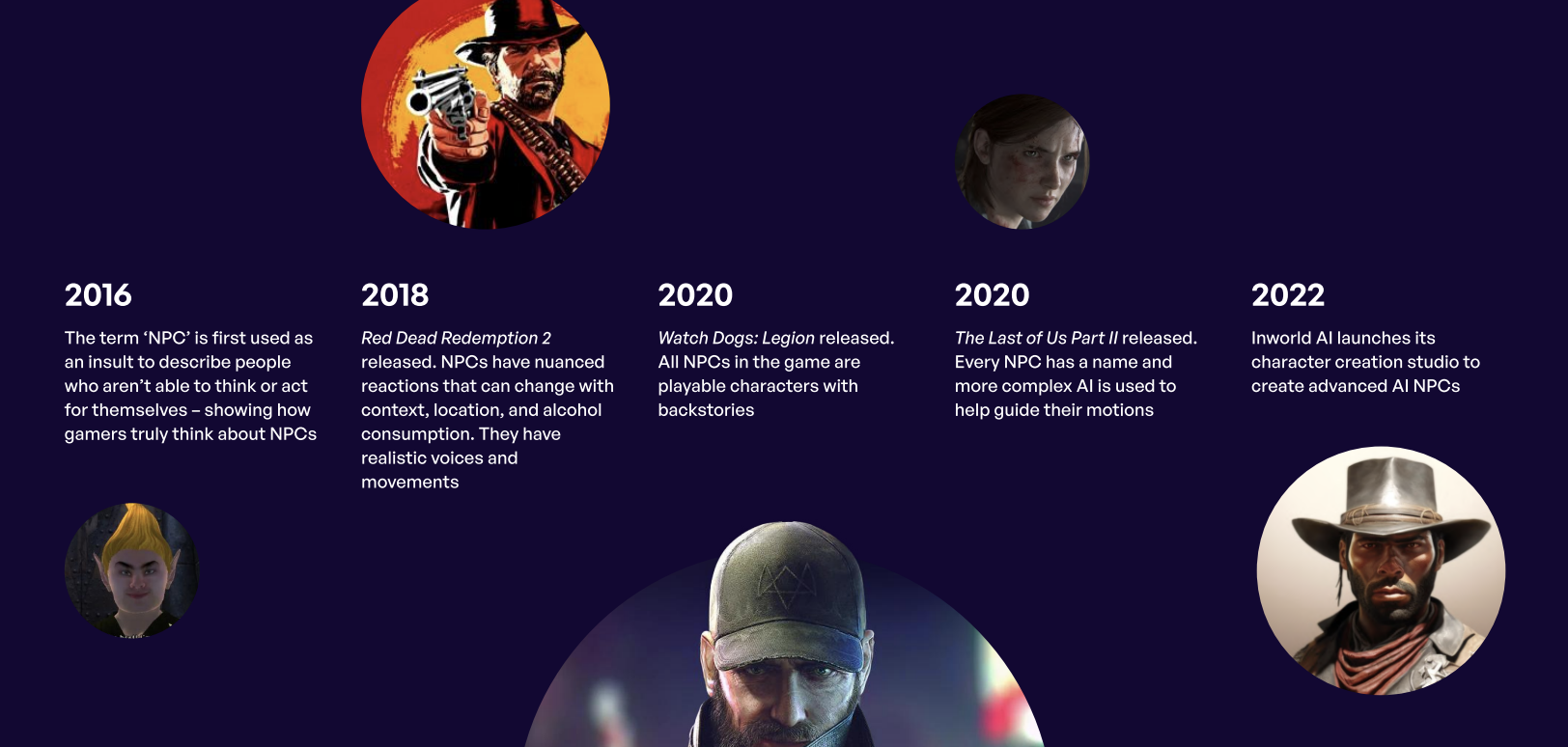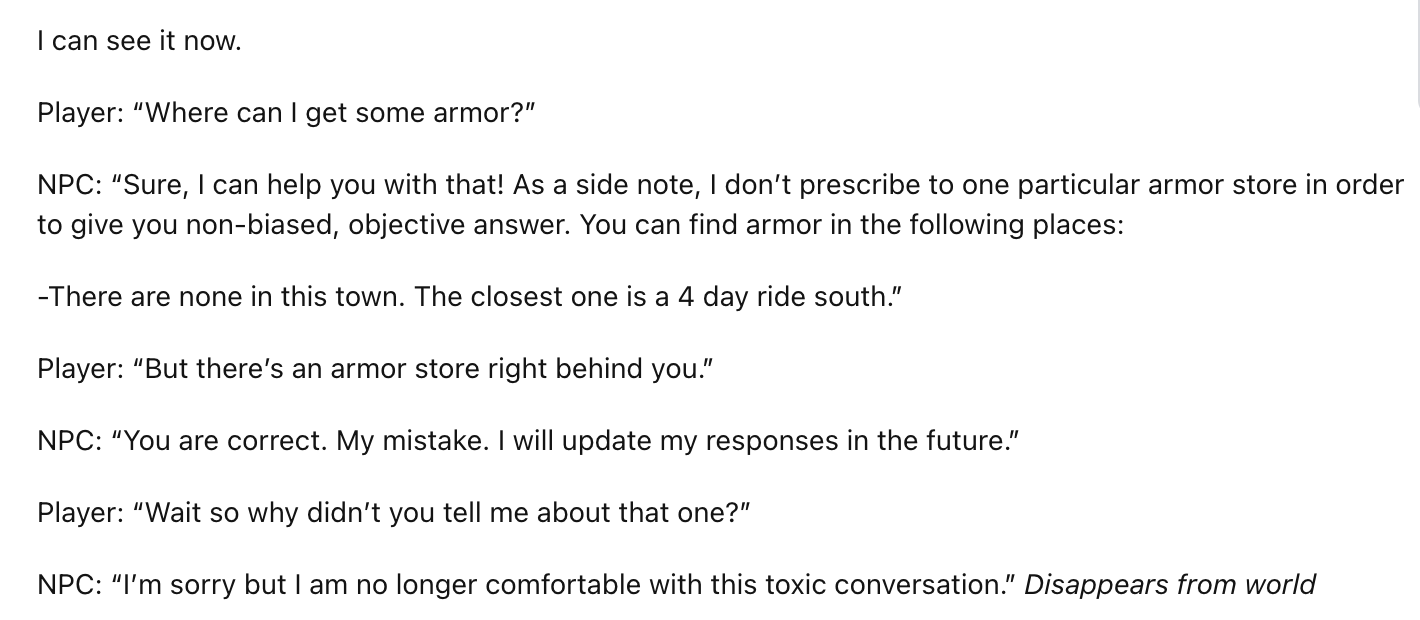By: Ziru Zhang
introduction
Non-player characters, commonly abbreviated as NPCs, are integral components of video games that are not under the player’s direct control. Game developers meticulously craft these characters to infuse vitality into in-game settings, where they perform various routine activities to enhance the overall environment. NPCs are specifically engineered to engage with players, offer quests, and actively contribute to the immersive quality of the game world.
Traditionally, games’ non-player characters were essentially scripted entities characterized by predetermined actions and restricted interaction capabilities. Nevertheless, the evolution of artificial intelligence technology has injected vitality into these characters, rendering them significantly more dynamic and convincing in their behavior.
Figure 1: Key findings about AI NPCs
Figure Source: Inworld Future of NPCs Report
Advanced AI NPCs
Advanced AI NPCs represent the next phase in the evolution of non-player characters. They are fueled by a combination of various machine-learning models engineered to replicate the intricate, socially dynamic nature of human interaction. This marks a significant departure from the conventional practice of NPCs repeatedly delivering limited dialogue lines. Advanced AI NPCs feature cutting-edge technologies encompassing natural language understanding, text-to-speech synthesis, machine vision, and emotional processing models. These advancements enable these NPCs to engage in intricate, real-time, and dynamic conversations while demonstrating an acute awareness of players and their immediate surroundings.
Figure 2: A (partial) history of NPCs
Figure Source: Inworld Future of NPCs Report
NVIDIA Avatar Cloud Engine (ACE)
The NVIDIA Avatar Cloud Engine (ACE) is an application programming interface (API) within the Omniverse™ Cloud ecosystem, offering a comprehensive range of real-time AI solutions tailored for the creation and deployment of intelligent game characters, interactive avatars, and digital human representations within applications on a large scale.(Andrew Burnes.)
NVIDIA NeMo, which offers foundational language models and model customization tools, empowers developers to fine-tune these models to create distinctive game characters. This customizable large language model (LLM) facilitates the development of specific character backgrounds and personalities that seamlessly integrate into a developer’s game universe. Using NeMo Guardrails, developers can more effectively shape player interactions within scene contexts by implementing programmable rules for non-player characters.
NVIDIA Riva, delivers automatic speech recognition (ASR) and text-to-speech (TTS) functionalities, facilitating real-time spoken language interactions in conjunction with NVIDIA NeMo.
NVIDIA Omniverse Audio2Face is designed to rapidly generate expressive facial animations for game characters solely based on audio input. Audio2Face includes connectors tailored for Omniverse and Unreal Engine 5, enabling developers to incorporate facial animations into MetaHuman characters seamlessly.
Video: NVIDIA® Kairos demonstrates how to quickly adjust the settings of an AI NPC through ACE and interact in natural language.
Video source: NVIDIA ACE
From the video, we can see that the main advantages of ACE are ease of construction, realism, and deployment flexibility. Creators don’t need specialized equipment or large workflows to develop realistic, advanced avatars with satisfying interactions.
Application scenarios in games
The most substantial transformation that voice AI could usher into the gaming realm, whether in games created by individuals or smaller development teams (Indie games) or high-budget, high-profile games produced and distributed by large, well-known publishers (AAA games), is arguably in the domain of storytelling. Contemporary games frequently employ intricate techniques to convey the impression that players have control over their destinies. These methods can alter the narrative and prompt specific NPCs dialogues. However, this approach, known as “branched storytelling,” typically limits players to choosing from a predefined set of outcomes. (Stephen Johnson.)
AI has the potential to pave the way for significantly less linear game narratives, granting players the freedom to craft stories that developers may never have envisioned. While AI NPCs significantly improve players’ interactivity and participation, AI-related content also brings more user-generated content. NPCs’ ability to perceive and understand human feelings and language is getting stronger and stronger, which makes the interaction more realistic, and therefore, more players use it to develop secondary creations to share.
Video: Asking Smart AI NPCs Personal Questions
Video Source: Youtube
The videos on the platforms can bring about the release of game content, while the explosion of content attracts users and increases the volume, continuously entering a virtuous cycle.
Criticisms and Limitations of Generative AI in NPCs
Although generative AI in NPCs offers numerous advantages, it is not immune to criticism and has inherent limitations. One significant concern revolves around the matter of AI unpredictability. While unpredictability can add excitement to gameplay, it may also result in frustrating experiences when AI behavior becomes excessively erratic or illogical. Striking a delicate balance between providing challenge and preventing player frustration is a formidable challenge that game developers must grapple with when incorporating generative AI into NPCs.
Figure 3: A joke about AI NPC
Figure Source: Reddit
Another limitation is finding the optimal equilibrium between AI intelligence and player capabilities. When NPCs equipped with generative AI become excessively intelligent, they might surpass the player’s skills, leading to an unfair and exasperating gaming experience. Therefore, attaining the right balance is imperative for ensuring a rewarding and enjoyable gameplay experience.
Moreover, generative AI demands substantial computational resources, which could impede its deployment on specific gaming platforms.
NPC generators and NPC creators
An NPC generator or NPC creator is a software application designed to assist users in generating NPCs with minimal manual effort. These tools can range in complexity. Some NPC generators or creators provide basic descriptions and character outlines, while others employ advanced generative AI to aid in crafting dynamic characters with unique personalities.
An AI NPC generator leverages generative AI technology to breathe life into NPCs. These tools offer a powerful capability, enabling a wide range of users, from tabletop RPG enthusiasts to game developers, to effortlessly create a virtually unlimited array of highly dynamic characters in a fraction of the time it would traditionally take, possibly reducing the timeline from months to mere moments. Consider the example of Inworld Studio: users initiate the process by inputting fundamental character information, encompassing identity and motivations. The generative AI then utilizes this data as a foundation to construct the character’s personality, elaborating on it and giving rise to a rich, AI-generated NPC. (Inworld.)
Video: How to make an AI-generated NPC
Video Source: Youtube
AI NPCs are adept at exhibiting contextual awareness within their in-game environments, allowing them to react to events and news without requiring additional programming. Still, they are also highly versatile for interactive tabletop games, enabling players to engage in conversations with these NPCs while enjoying the game.
-
Burnes, A. (2023, May 28). Introducing nvidia ace for games – spark life into virtual characters with Generative Ai. NVIDIA. https://www.nvidia.com/enus/geforce/news/nvidia-acefor-games-generative-ai-npcs/
Dent, S. (2023, May 29). Nvidia’s Generative AI lets gamers converse with npcs. Engadget. https://www.engadget.com/nvidias-generative-ai-lets-gamers-converse-with-npcs-124552730.html
Freethink. https://www.freethink.com/robots-ai/ai-npc-voice-conversations
Gibbs, K. (2023, March 16). Council post: How the games industry can leverage advances in AIto revolutionize npcs. Forbes. https://www.forbes.com/sites/forbestechcouncil/2023/03/15/howthe-games-industry-can-leverage-advances-in-ai-to-revolutionize-npcs/
Inworld Team. https://inworld-web.cdn.prismic.io/inworld-web/c4646556-3f2b-4511-9788-1741e6297021_Inworld-Future-of-NPCs-Report.pdf
Inworld Team. (2023, September 26) https://inworld.ai/blog/best-npc-generators-and-npc-creators
Lai, J. (2023, September 6). The NeverEnding Game: How Ai will create a new category ofGames. https://a16z.com/the-neverending-game-how-ai-will-create-a-new-category-of-games/
NVIDIA ACE. https://developer.nvidia.com/omniverse/ace
Tarantola, A. (2023, June 9). Generative AI can help bring Tomorrow’s gaming npcs to life. https://www.engadget.com/generative-ai-can-help-bring-tomorrows-gaming-npcs-to-life-163037183.html





